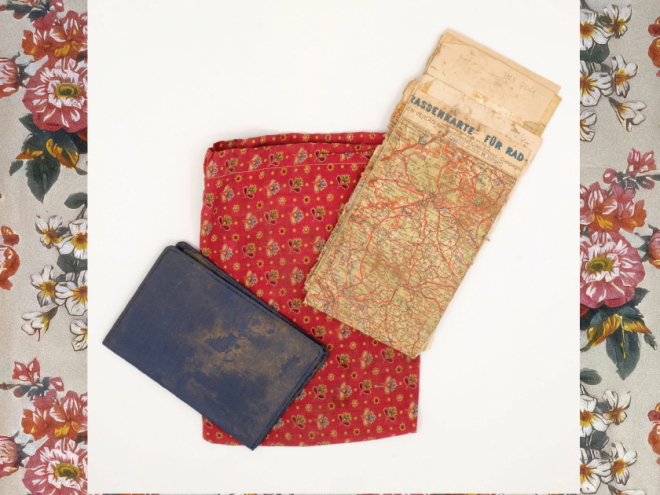In his introduction to Two Wheels to Freedom, author Arthur J. Magida makes an unusual plea: “Even if you think you’ve heard it all [about World War II] before and you don’t want to hear it again, read on!”
Magida’s book chronicles the story of Cioma Schönhaus, a Jewish art student who lived in wartime Berlin as a “U‑Boat,” the name that Jews gave themselves as they hid in the capital of the Nazi Reich. In 1942, there were 65,000 Jews still in Berlin, and an angry Joseph Goebbels ordered transports to take them “east.” Most never returned. By the end of the war, only two thousand survived. Cioma was a most improbable survivor, “a connoisseur of outrageous, life-saving and totally original gestures.”
As the noose tightened around the Jewish community in Berlin, Cioma’s middle-class family began to suffer. Alarmed by the growth of the Hitlerjugend (the Hitler Youth had eight million members by 1938), Cioma’s optimistic mother, Fanja, signed him up for Hashomer Hatzair, a Jewish youth group. Ironically, to go out in public, the boys had to wear camouflage — the boots, white socks, and brown shorts of the Hitler Youth.
The mood in Berlin became increasingly desperate. One observer noted it was a “soulless existence: the flowers had gone, the books had been burned, the pictures had been removed, the trees had been broken.” Magida adds, “Officially, fun was a crime, and laughing was a sin.”
The Gestapo raided the Schönhaus apartment, and Cioma’s father, Boris, was arrested for selling butter on the black market. Both parents were sent to concentration camps — Sobibor and Majdanek — where they perished. Cioma was exempt because he worked in the Genschow armaments factory.
Against this perilous background, Cioma, a spunky young man with a flamboyant, bohemian bent, still sought out friends and girlfriends, discarded the mandatory yellow star to go out drinking and dining, and even purchased a boat to sail on Lake Stössensee. He “came as close to being a Parisian boulevardier as a Jew could be in the Third Reich.” Yet even though he moved through the world with brio and an “innate cockiness,” he was at loose ends, wondering how to make sense of his troubled surroundings. He knew of Jews who needed help, who were betrayed, or who died by their own hands or by the Nazis’. Though he couldn’t save his parents, “he hoped he could save someone else.”
Cioma’s life changed when he was recruited by Franz Kaufman and Helene Jacobs to use his artistic skills to forge documents for Jews. The two attended the local church, St. Anne’s, where Martin Niemöller — author of the famous quote “First they came for the Communists, and I did not speak out because I was not a Communist … ” — served as pastor. Parishioners handed Cioma identity papers so that he could transform them into documents that would save the lives of hundreds of Jews.
Meeting members of the resistance gave him “a glimpse of a world he’d heard about where people … refused to submit to the Nazis.” As he undertook the laborious, detailed work of forging many kinds of documents — from birth certificates, to ration cards, to military papers — he found a new reason for being.
When Kaufman and Jacobs were arrested, Cioma became a wanted man. The Gestapo posted his photograph in police stations throughout Germany, and he knew he would have to leave. After considering various escape routes, he decided to bicycle his way to Switzerland. He faced many obstacles: the Swiss border was six hundred miles away, he had to obtain maps, and — the biggest challenge of all — he had to find a bicycle, an almost impossible task in wartime Berlin.
Magida relates Cioma’s riveting story in vivid detail. Though at times the pitch may seem too breezy for such a serious subject, Magida does well to capture the tone of a young, careless, and carefree man. However, the title is a little misleading. The majority of the book focuses on Cioma’s life in the Jewish community in Berlin, rising Nazi control and terror, and Cioma’s underground work as an esteemed forger. This part of the story is just as gripping as his bicycle escape to Switzerland, which occupies only the last few chapters.
Magida — a Pulitzer Prize – nominated author and journalist, and the editor of the Baltimore Jewish Times—was fortunate to spend many days interviewing Cioma Schönhaus before he died just shy of his ninety-third birthday in 2015. He was still “spry, stubborn and armed with a terrific memory … with the same pluck that had saved him during the war.” The author concludes, “If Cioma had learned anything, it was that if you’re going up against the devil, you do it with style, panache and a jauntiness that keeps him off balance.”
Elaine Elinson is coauthor of the award-winning Wherever There’s a Fight: How Runaway Slaves, Suffragists, Immigrants, Strikers, and Poets Shaped Civil Liberties in California.




